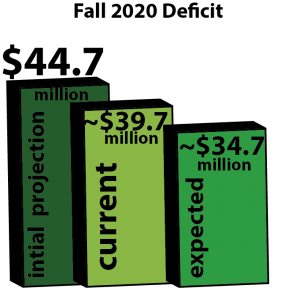College Deficit $5 Million Less Than Expected, Trustees Roll Back One-Time Salary Cuts
While COVID-19 complications and the three semester plan have created a budgetary shortfall for the College, the current deficit is almost $5 million less than originally projected and is expected to improve further. This positive forecast has prompted the Board of Trustees to roll back the faculty wage freeze and senior staff pay cuts that were instituted at the beginning of the school year.

The 2020–2021 academic year was initially projected to produce a total budget deficit of $44.7 million due to COVID-19 safety measures and an anticipated decrease in enrollment. While the College initially projected that enrollment would drop by 20 percent, the actual enrollment drop this semester has only been 11 percent.
The College expects this enrollment trend to continue through the spring and summer which would result in Oberlin recouping an additional $5 million. If enrollment holds steady and the campus remains open, the College expects to be $10 million better off at the end of the year than projected this summer, leaving the deficit at $34.7 million.

Over the summer, when College administrators were weighing options for the coming semester, projections showed that the three-semester plan was more financially viable than the proposed alternatives.
“The three semester plan enables us to best manage the level of deficits for [financial year] 2021,” Vice President for Finance and Administration Rebecca Vazquez-Skillings wrote in an email to the Review. By contrast, “a remote campus experience produces deficits of approximately $70 million.”
COVID-19 precautions account for an estimated $8 million of the total budget deficit. The increased safety measures include COVID-19 testing for faculty and staff, improvements to technology and facilities, and investment in protective equipment and additional personnel.
To cover the deficit, the College made an extraordinary withdrawal from the endowment. It also initially enacted a series of one-time cuts which included cuts to faculty and staff compensation, among other measures. After receiving the improved budget projections, the board authorized a two percent, one-time wage increase for faculty and staff, reinstated senior staff salaries to the 2019-20 base level, and provided additional crisis pay to some administrative and professional staff members.
Pre-existing Financial Troubles
Prior to the COVID-19 crisis, the College was already facing significant structural deficits. To address these systemic issues, the College developed One Oberlin recommendations in 2018 to balance the budget. One Oberlin implementation began last year with the expansion of Winter Term, the development of new postgraduate certificate programs in the Conservatory, new concentrations in the College, and the decision to outsource custodial and dining services.
This year’s increased financial deficits have only exacerbated the need for change already espoused by administrators.
“Before the pandemic, Oberlin planned $6.8 million in reductions associated with the One Oberlin roadmap and these reductions were projected to produce a balanced budget,” Vazquez-Skillings wrote. “Next year’s budget assumes that we will still achieve those necessary budget reductions.”
One Oberlin implementation continues this year. The implementation of some recommendations — such as the commitment to admit 100 fewer students to the Conservatory and enroll 100 more in the College — were delayed this year due to disruptions caused by COVID-19.
“The pursuit of One Oberlin’s goals remains a priority,” Vazquez-Skillings wrote. “The pandemic has impacted our journey. However, significant progress has been made on a number of fronts, including: career development initiatives, engaged liberal arts programs and a number of business process efficiency efforts.”
Extraordinary Withdrawal from the Endowment
The Board of Trustees approved a significant withdrawal from the endowment to cover a majority of this year’s budget deficit.
“We typically utilize 4.5 percent of the endowment each year, which is about $40 million,” President Carmen Twillie Ambar wrote in a June 12 email to faculty and staff. “Our current projections indicate that we will need to increase our withdrawal to eight percent, for a total draw of more than $70 million.”
As of 2018, the College had an endowment of $887.4 million — although shifts in the stock market during the pandemic will have impacted this amount.
“Like most investments, our endowment was impacted by the recent market volatility,” Vazquez-Skillings wrote. “Fortunately, it has recovered some of its losses.”
Enrollment
While the College was successful in recruiting students to apply to Oberlin, maintaining enrollment was still a concern for Admissions over the summer.
To reduce summer melt — the number of first-year students who decide not to enroll in the year and school to which they initially committed — the College worked to engage admitted students over the summer. This included remote summer classes about COVID-19 and other topics, podcast discussion groups led by Peer Advising Leaders, and chances to meet faculty through department open houses. Throughout the fall semester, the PAL program has continued to provide support to first-years. According to Assistant Vice President for Institutional Research and Planning Ross Peacock, very few first-years have withdrawn their enrollment since the semester started.
President Ambar agrees that enthusiasm from students has been crucial.
“I do think that our students voted with their feet in terms of choosing to return even in this complex pandemic,” President Ambar said. “I’m hopeful that part of the reason why our students returned was because they had confidence in the plan that we presented — the layered healthcare strategy.”
One-Time Cuts
The College committed to cut short-term costs to offset losses. These cuts included a wage freeze across positions, a hiring freeze with limited exceptions, the suspension of retirement contributions, the suspension of College-sponsored travel and conference attendance, the suspension of study away for the fall, and reductions in temporary staffing and overtime.
In addition to these measures, President Ambar received a one-time 10 percent reduction to her salary and senior staff received a five percent reduction to their salaries. Senior staff’s salary reduction has since been reversed. No other faculty or staff members had pay reductions.
“The Board has restored approximately $2 million of the $20.3 million in cuts to support one-time investments in compensation,” Vasquez-Skillings wrote. “Trustees recognized the improving budgetary situation and authorized a 2%, one-time wage adjustment for faculty and staff. In addition, the board authorized crisis pay to acknowledge the extraordinary efforts of key administrative and professional staff. The Board also reinstated senior staff compensation to the 2019-20 base level.”
The College increased compensation to acknowledge the immense work that faculty and staff have undertaken this year. They also had to consider the possibility that the deficit could increase in the next two semesters due to the unpredictable nature of the pandemic.
“The board had to think about that and balance the uncertainty with also wanting to make sure that we continue to be able to invest in the faculty and staff who work here, and think in clear-eyed ways about the tremendous work that occurred over March, April, May, June, July, and August,” President Ambar said. “Changing from two semesters to three semesters, along with all of the COVID mitigation work, I’ve described it as literally rebuilding the college from the ground up in about two and a half months.”
Future Uncertainty
Chair of the Board of Trustees Chris Canavan explained that, although the College is currently performing better than its initial projections, College leadership is still proceeding with caution.
“We’re happy to report that we’ve done better than what we projected,” Canavan said. “But we’re still facing an enormous amount of uncertainty, and so we need to make sure that we retain as much financial flexibility as possible. We just have to prepare for what might happen when it’s very difficult to see out more than a month or two.”
Vasquez-Skillings explained that enrollment remains the hard-to-predict variable which will determine the balance of the budget for the next two semesters.
“Actual spring and summer semester enrollments may impact our projections,” Vasquez-Skillings wrote. “We continue to monitor this situation closely, with our next checkpoint being spring enrollment. We are hopeful to gain a stronger sense of spring enrollments before the end of the calendar year.”
Ambar discussed a few of the factors which make the future hard to predict.
“I’m optimistic about what this spring and summer will be, but the realist in me knows that all of the data and research says we will have a fall surge, and what that looks like in Ohio and how that looks in Oberlin is not predictable,” President Ambar said. “You all go home at Thanksgiving and then we all come back again in January, and we have to do the same thing that we did in August, which is test everybody. … All of those things make me a realist about what the spring and summer looks like, and therefore unable to give you a pinpoint prediction of whether this better performance that we’ve had financially will carry all the way through the spring.”
Should campus need to move fully online, Vazquez-Skillings wrote that the College would likely recoup funds from the eliminated costs of dining and on-campus programs. Reductions, she said, would likely come in the form of voluntary and mandatory furloughs, as well as reductions to compensation with the priority of filling any vacant positions.






